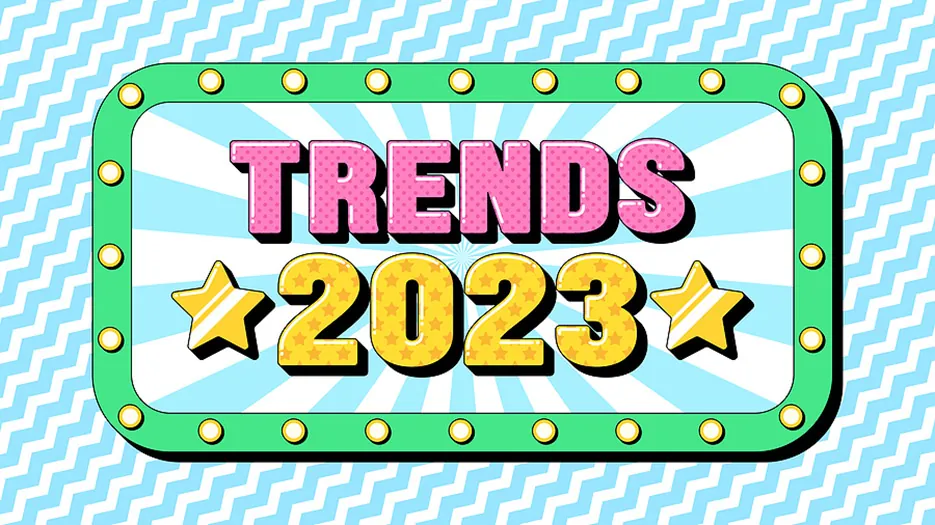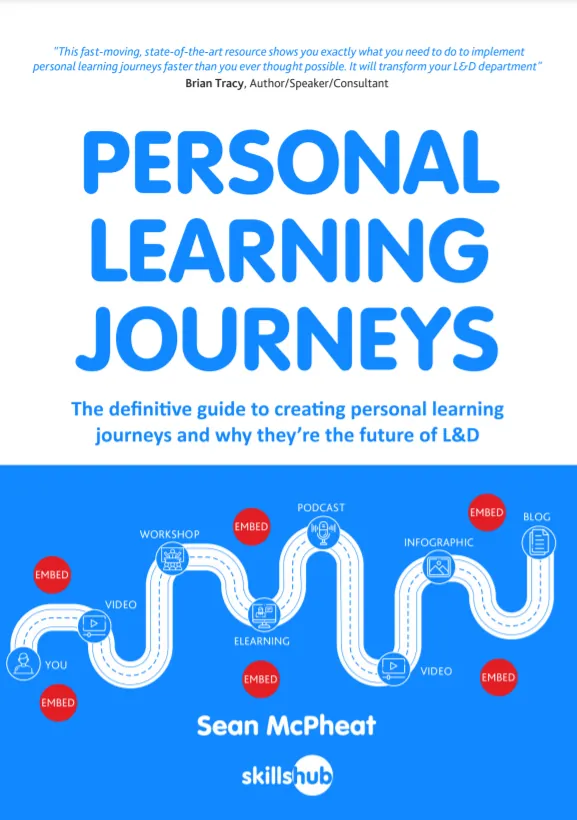
Here’s nine trends for the learning and development universe to consider for 2023.
The learning and development industry evolves each and every year. New trends emerge, some fall off the radar completely and others metamorphose themselves into other formations (the LMS to LXP to Online Learning Platform as an example!).
L&D professionals all over the world are always looking for the latest trends to keep up to date, but also to validate and confirm whether their current strategies and plans are on the right route.
Please note that these trends are positioned towards organisations that don’t have huge L&D budgets. Often, many trends are completely out of reach for most L&D departments, so we’ve positioned our predictions with small to medium-sized organisations in mind.
We speak with hundreds of L&D professionals every year and coupled with our own industry knowledge and research we have compiled a list of learning and development trends for 2023.

1. Career Path Learning
Much has been said about self-directed learning or learning in the moment of need. But what about career development? L&D professionals should be looking at the skills that each employee needs to become more effective in their role and the skills they need to acquire or develop for their future career aspirations.
When an employee can see tangible benefit at the end of learning – for example, something that will help with an internal promotion or sideways move, they will become more motivated to learn.
Career path learning should be on the agenda when looking at online and offline development opportunities.
2. Impact & Purpose Over Usage
Do you use a learning management system to help develop your people?
If you do, then maybe you have been guilty of focussing on these questions:
“How many courses are learners taking?”
“How many times have learners logged on?”
“How many minutes of learning has everyone taken?”
“How many learners have not logged on in the last month?”
Some L&D professionals are obsessed with system usage when they should be more obsessed with intent, outcomes, and impact.
Who is getting the most out of the learning platform in the following example?
Learner A who takes 10 courses per month and is at the top of the engagement leaderboard. They love learning and can’t wait to take the next course. They haven’t seen many of the benefits from the learning they have taken.
Or
Learner B who is low in the usage statistics but the learning they have taken has resulted in retaining two people in their team because of some coaching and performance management knowledge they covered. In addition, they have secured a renegotiated contract with a supplier which resulted in a £20,000 reduction in total fees. Both outcomes can be directly attributed to a technique that was covered in the learning.
It’s important that you work out what success means to you and what’s most important. Is it consumption? Is it transfer of learning into the workplace? Or is it impacts and outcomes?
Our trend for 2023 is to focus on the impact of your learning systems, not simply usage.
3. Personalised Learning
Personalised learning is a recurring trend as more and more L&D professionals get to grips with what it entails. You can learn more about how to create Personal learning journeys in my book. Whether it’s online or offline learning, in 2023 L&D professionals need to think about how we can create personal learning experiences for our people.

Learn How To Create Personal Learning Journeys For FREE!
4. Resources, Not Just Courses
Before the growth of online learning, teams would be presented with a booklet of courses that outside third-party training providers were running, where they could then select the course(s) they were interested in.
For many businesses who haven’t updated their training processes, sadly that’s still the case.
In 2023, we need to be thinking more about offering learning resources, not just courses.
These resources can include and not limited to:
• Online learning
• Elearning content
• Videos
• Blogs
• Audios
• Podcasts
• Virtual training
• Assessments and quizzes
• Infographics
• Conferences
• Mentoring
• Coaching
• Whitepapers
• Whether these are housed on an elearning platform or not, think resources, not just courses.
5. Mobile Learning
The reason that mobile learning is included in our list is due to the decline of desktop usage in communication, especially amongst millennials where it’s reported that 20% use ONLY their smartphone to communicate.
This will continue to grow. Weonly have to look at how the teens around us shun the TV and laptops in favour of their phones. It’s how they prefer to learn and consume information, and I can’t see that changing.
Mobile learning has its pros and cons. It’s horses for courses. It all depends on what your preferences are and where you prefer to learn.
Our prediction for 2023 is that businesses will need to more closely consider how they can incorporate mobile learning into their training programs, allowing employees to carry out training on the go or wherever suits.
6. Hybrid Learning
A lot of organisations are moving towards a hybrid model of working, hence it’s only natural for hybrid models of learning to start to appear.
It’s important to understand the difference between hybrid and blended learning, which are actually very different premises.
Blended learning is when a learner chooses or is part of a programme that combines eLearning and traditional classroom-based workshops.
Hybrid working is when a learner chooses to attend in-person or online for the same learning event. So, there could be four people in a room in-front of a facilitator and five people at work around the country participating online.
In 2023, businesses should ensure they are offering their learners hybrid learning opportunities. In other words, the option to join in-person or remotely, so they can learn in an environment that suits their preferred learning style.
7. Assessment First Learning
Something that is often overlooked is the value of rote learning, which is all about understanding a topic based upon repetition.
Traditionally, learners will take an assessment after they have covered the theory and contents of a topic, whereas assessment-first learning is the opposite.
The assessment-first approach can be broken down into two ways:
• Intense Consumption of Assessments
Imagine that your LMS has a section dedicated to assessments and quizzes. There’s no learning in there, just assessment after assessment. The topics can range from leadership styles through to your internal processes.
With this, your learners take the assessments, they receive a score and feedback on the questions they get right and wrong and they can take them time and time again until they get all the questions right.
• Assessment-First and then Self-Guided Learning
Similar to the above scenario, however this learner is told the right and wrong answers and they then must investigate and find out the answers via the content on their LMS. It can be compared to a flipped classroom but for assessments.
L&D professionals should consider introducing assessment-first learning into their workplaces in 2023 to mix up the styles of learning and ensure learners fully grasp the ideas being taught.
8. The Rise of Infographics
A picture paints a thousand words. I’m surprised at organisations that are still forcing their learners to read documents, workbooks and the like when a simple infographic would do the job perfectly.
A lot of your learners will think in pictures and will prefer to consume information this way so it’s important that you cater to them.
If you’ve got an LMS, make sure that you have a section dedicated to infographics and images that can be used as standalone assets as well as being blended into online and offline programmes.

9. Learning Content Trends for 2023
This next and final trend is focused on key considerations to keep in mind for 2023 when creating learning content for your team. These have been taken from the last three months of bespoke eLearning requests that the Skillshub team have received.
Neurodiversity
Neurodiversity is based on the premise that people have different ways of thinking, behaving, and learning. There’s no right or wrong way with this – it’s just a different version of the world according to them.
Neurodiversity is about educating your people about this and making sure that your learning content is accessible and suitable for those with neurodiverse conditions.
Some examples of neurodiverse conditions include:
• Autism
• ADHD
• Dyspraxia
• Dyslexia
• Dyscalculia
• Dysgraphia
• Tourettes
Resiliency
The challenges that your people face in and out of work are ever increasing. The cost of living, the constant uncertainty that COVID brings, war, the economy and a whole host of other factors mean that our people have a lot to cope with.
In terms of your organisation, never before have they needed to be as agile with their ways of working and the different business models being adopted.
There’s a lot of change going on meaning resilience training is in high demand. Resilience training will provide your people with the techniques and strategies to better cope so the changes they face will become more manageable and will help to protect against mental health and wellbeing issues.
Hybrid Working
Pre-COVID the number of hybrid workers who came into the office some days and worked from home on others were few and far between.
Today, hybrid working is becoming an expectation for job candidates and in building a flexible and healthy workforce.
But along with this comes its challenges for your employees and their line manager.
Some of the main challenges include:
• Lines of communication
• Connection and belonging
• Collaborating with others on projects and work
• Creativity and brainstorming ideas
• Feeling part of and contributing to the culture
• Leading remote workers
Mental Health
Coupled with resilience, mental health training can have a positive impact on your employees so they can cope with the daily demands that they face.
Mental health training has the following benefits:
• It challenges the stigma of mental health – no one is immune to it
• It builds and creates awareness of what it is and the signs of it
• Provides techniques and coping strategies to help
• Develops empathy throughout your organisations
• Creates a supporting culture for everyone
• Managers will look out for the wellbeing of their people a lot more
EDI
EDI means equality (sometimes referred to as equity), diversity and inclusion.
Our working world has never been so diverse so it’s important that we can build the awareness of and encourage EDI in the workplace.
Some of the benefits of this include:
• Creating a happier and harmonious workforce
• Increased levels of motivation due to feelings of belonging
• Prevention of legal issues such as:
o Discrimination
o Bullying
o Harassment
How many of these learning and development trends for 2023 are part of your current learning and development strategy or are in the planning stage? If none of them, this doesn’t mean your organisation is failing. Chasing the latest trend is not always guaranteed to improve your people or organisation and you must always do what’s best for your organisation.
These trends are designed to provide L&D professionals and organisations with inspiration and food for thought for how they can improve and adapt their training strategies to the current times.
If you’re ready to level up your L&D strategy with the help of an eLearning company, get in touch with us today!













